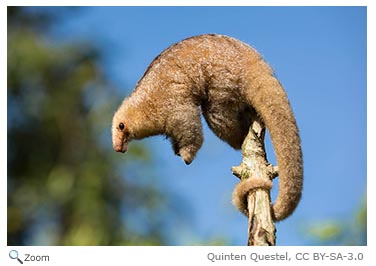Cyclopedidae -
Silky Anteaters |
|
|
 There is one species in this family. The silky anteater is found in the forests of southern Mexico south to Bolivia. The silky anteater is nocturnal and rarely leaves the protection of the trees. There is one species in this family. The silky anteater is found in the forests of southern Mexico south to Bolivia. The silky anteater is nocturnal and rarely leaves the protection of the trees.
The silky anteater is also known as the pygmy or dwarf anteater. It is about 14-17 inches in length. It has thick, silky yellowish-brown fur; a short snout; and a long, partially prehensile tail.
Female silky anteaters give birth to a single baby. She makes a nest of leaves in a hole in a tree. Both the male and the female care for the young. The male will carry the baby anteater on his back.
World Status Key
 Least Concern Least Concern  Near Threatened Near Threatened  Vulnerable Vulnerable  Endangered Endangered  Critically Endangered Critically Endangered  Extinct in Wild Extinct in Wild  Extinct Extinct  Not Enough Data Not Enough Data
Status and range is taken from ICUN Redlist.
U.S. Status Key
 Threatened in US Threatened in US  Endangered in US Endangered in US  Introduced Introduced
Status taken from US Fish and Wildlife. Click on U.S. status icon to go to the U.S. Fish and Wildlife species profile. |
|
New Hampshire Status Key
 Threatened in NH Threatened in NH  Endangered in NH Endangered in NH  Breeds in NH (birds) Breeds in NH (birds)
Status taken from NH Fish and Game |
Location Key
 Africa Africa  Asia Asia  Australia/Oceania Australia/Oceania  Europe Europe  North America North America  South America South America  NH NH  Click for More Info Click for More Info  Click for Image Click for Image
New Hampshire Species |
|
North/Central American Species |
| None |
|
Silky Anteater - Cyclopes didactylus     
|
Other Species Around the World |
| None |
|
|
Additional Information
Key:  Profile Profile  Photos Photos  Video Video  Audio Audio
Silky Anteater- Cyclopes didactylus     
Both silky anteater parents feed their young regurgitated insects.
Source: Animal Diversity Web Intended Audience: General Reading Level: Middle School
Silky Anteater- Cyclopes didactylus     
The silky anteater has long, curved claws on its front paws that help it move around in trees.
Source: Arkive Intended Audience: General Reading Level: Middle School |

